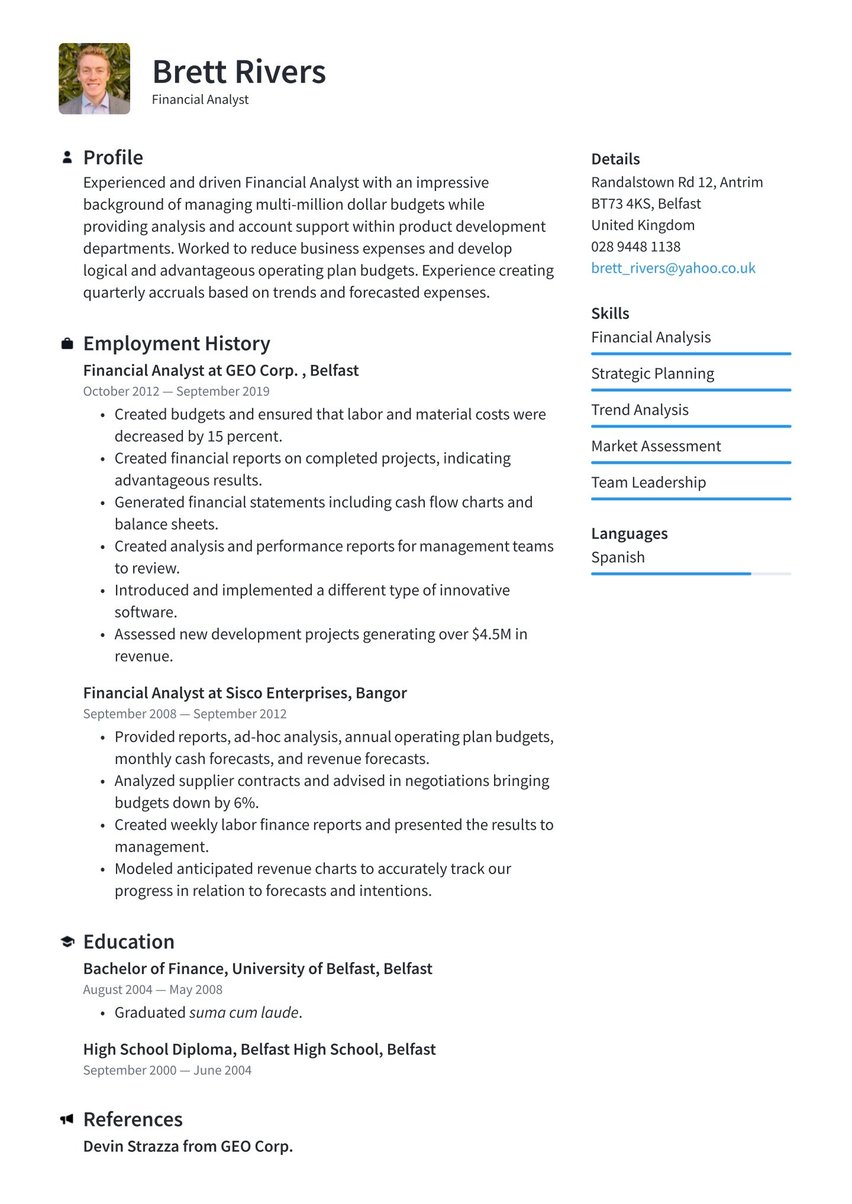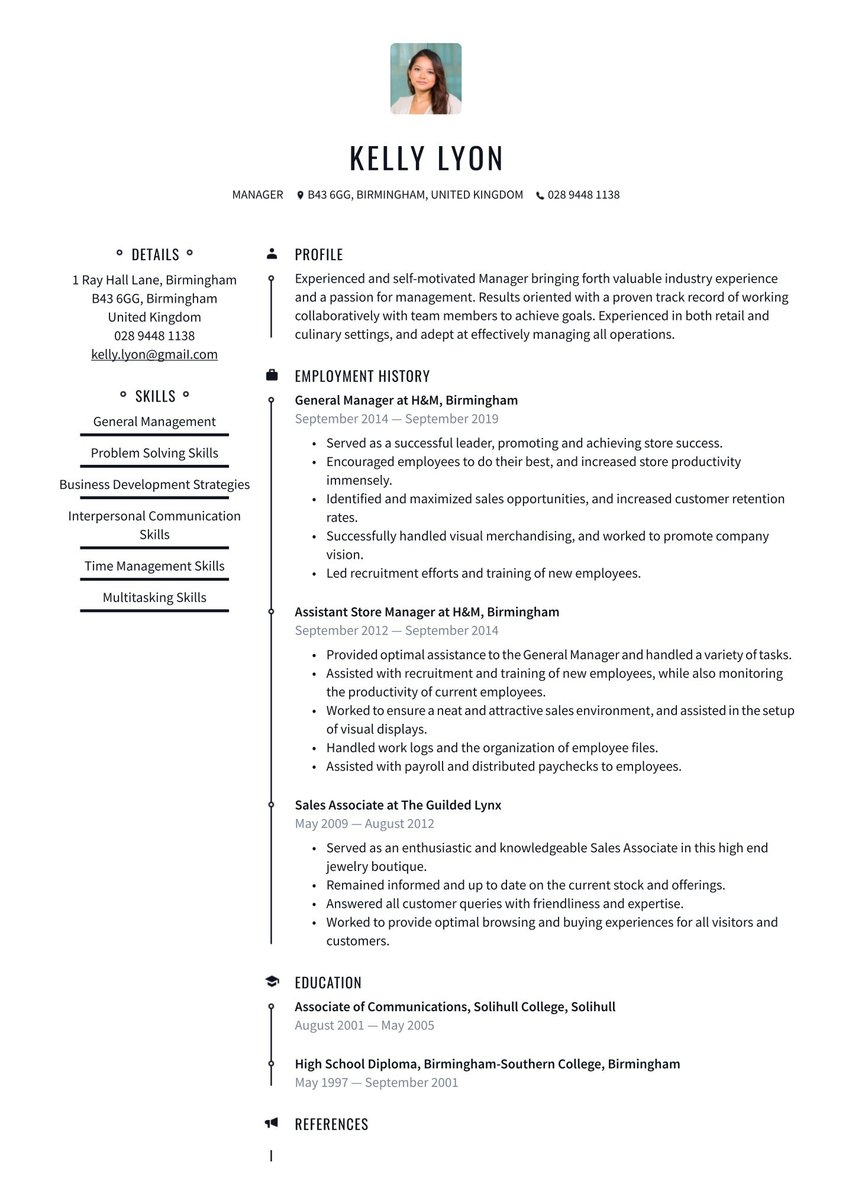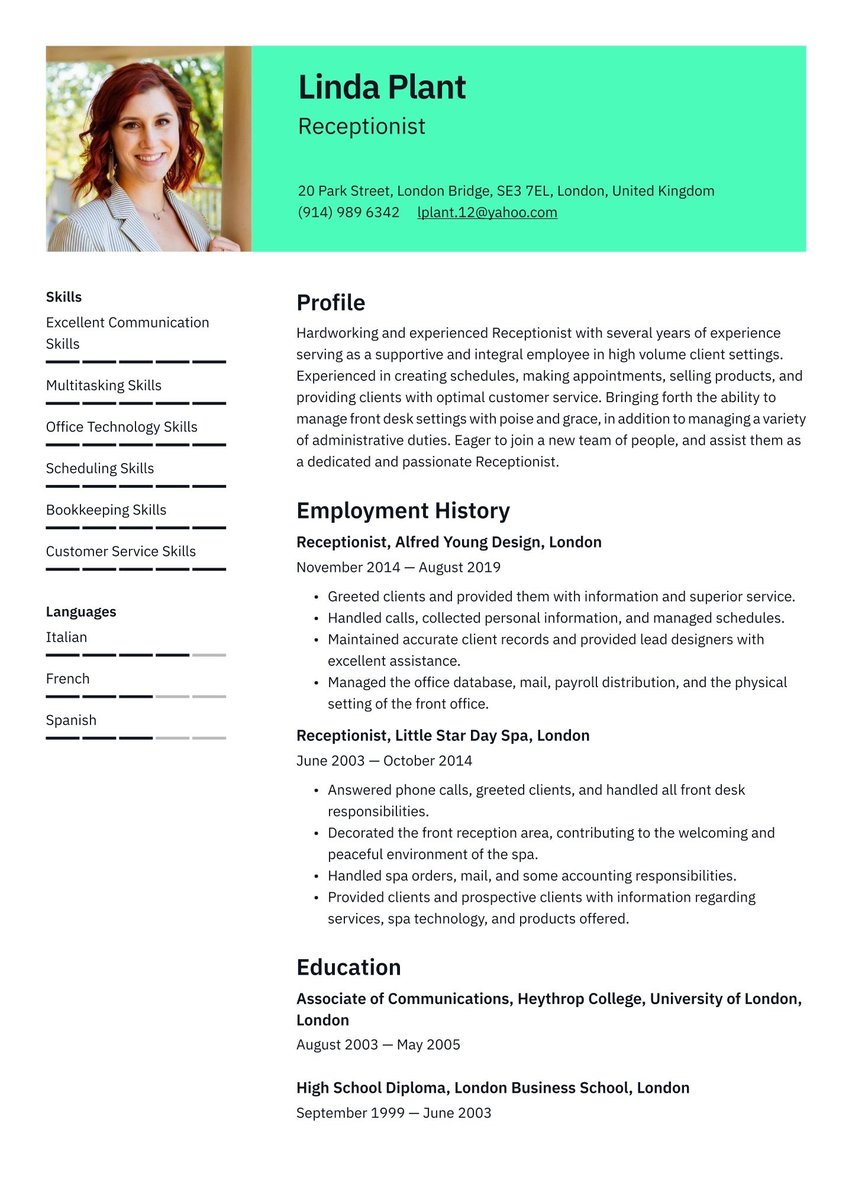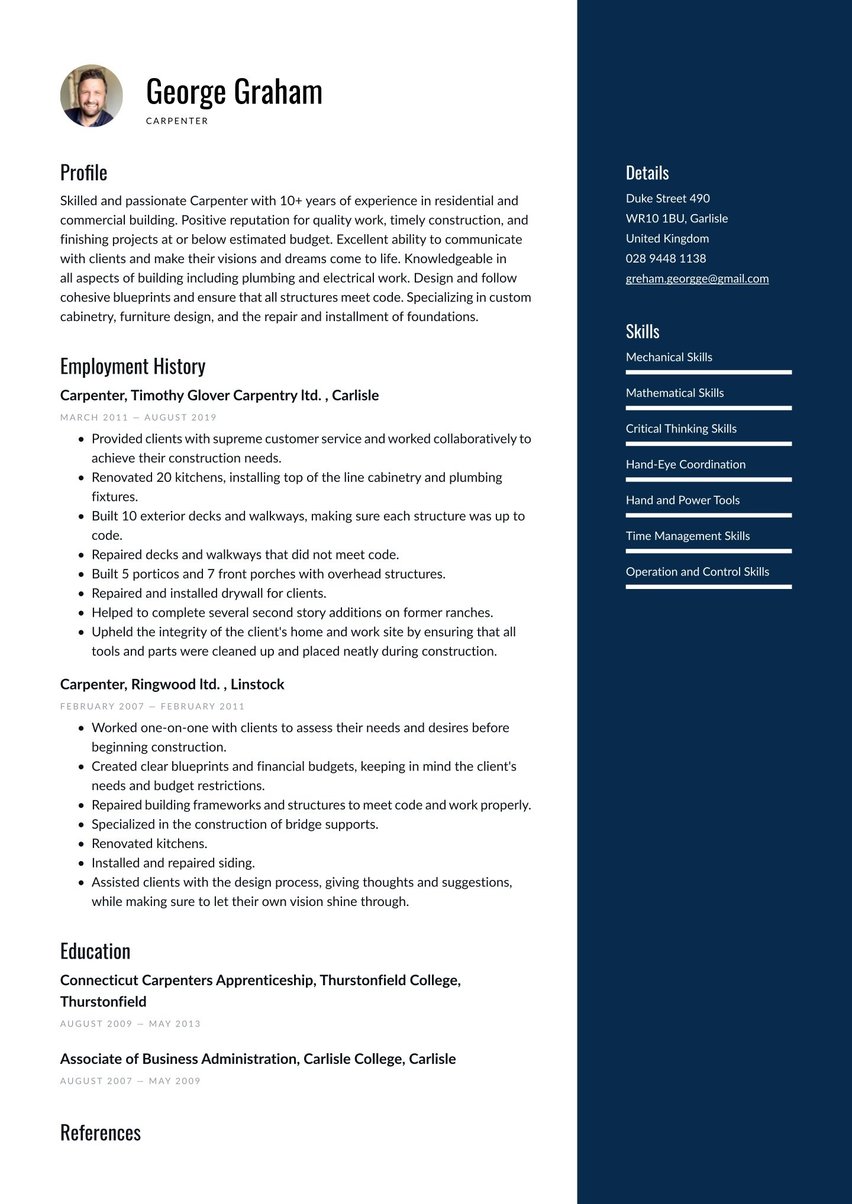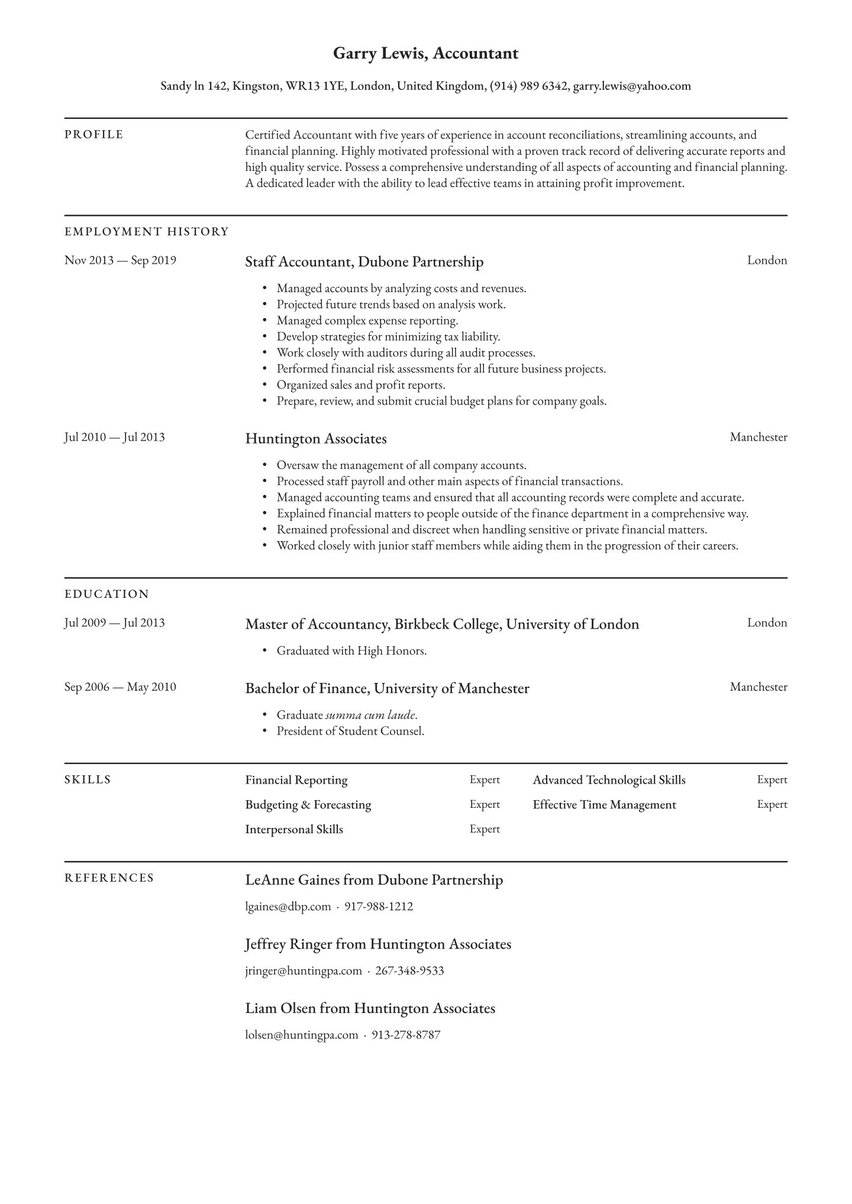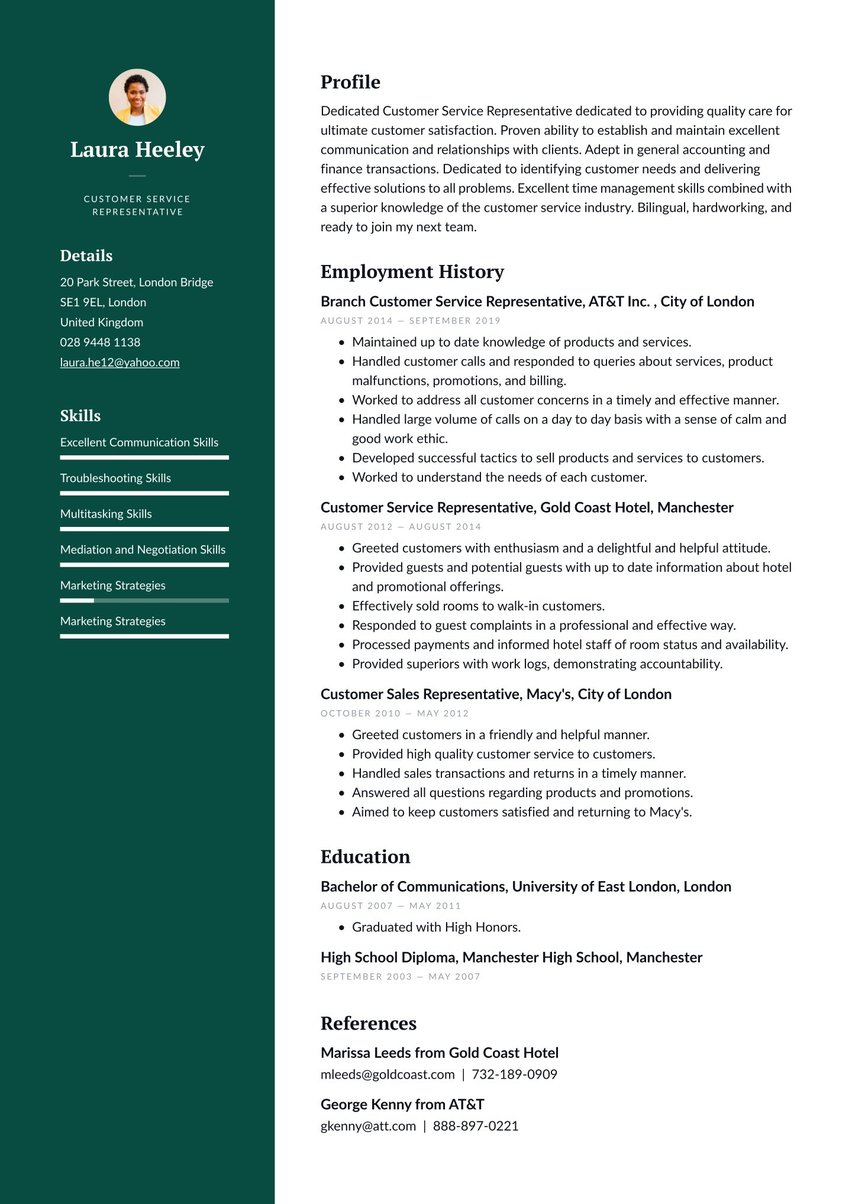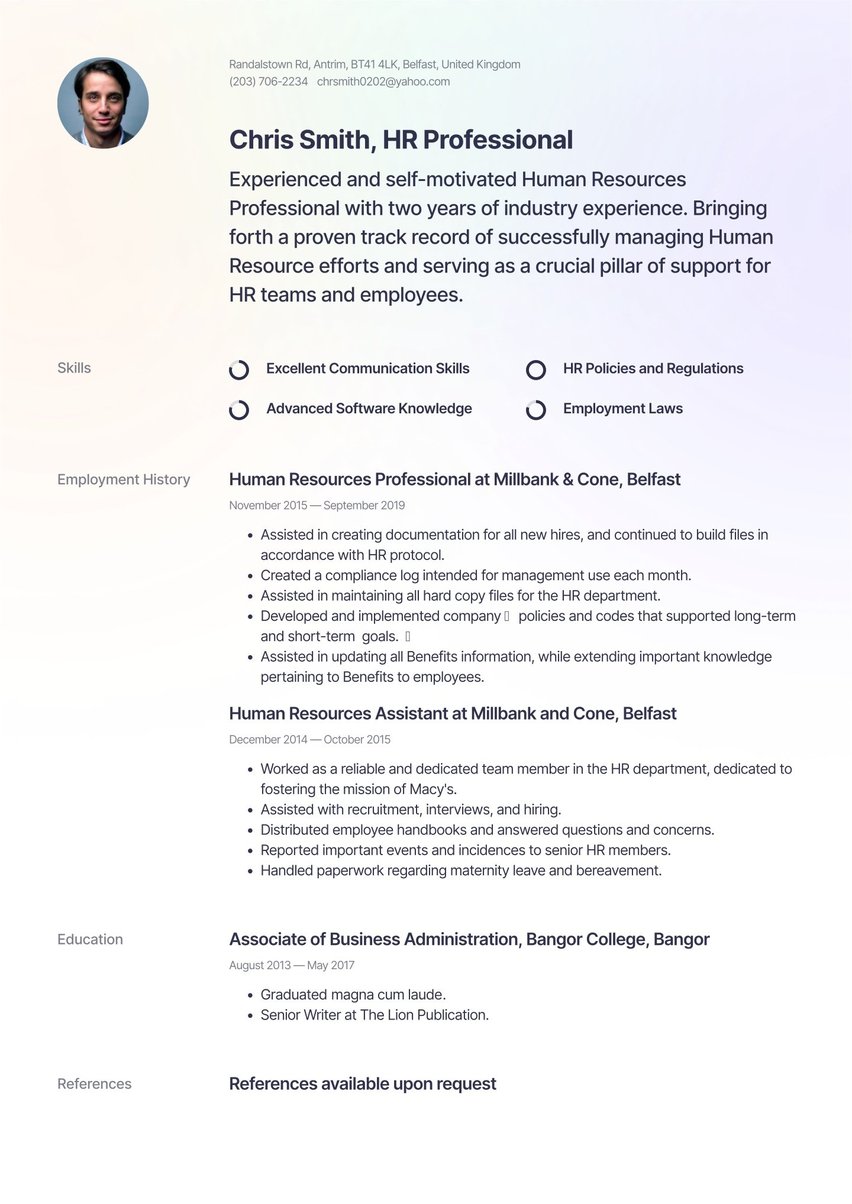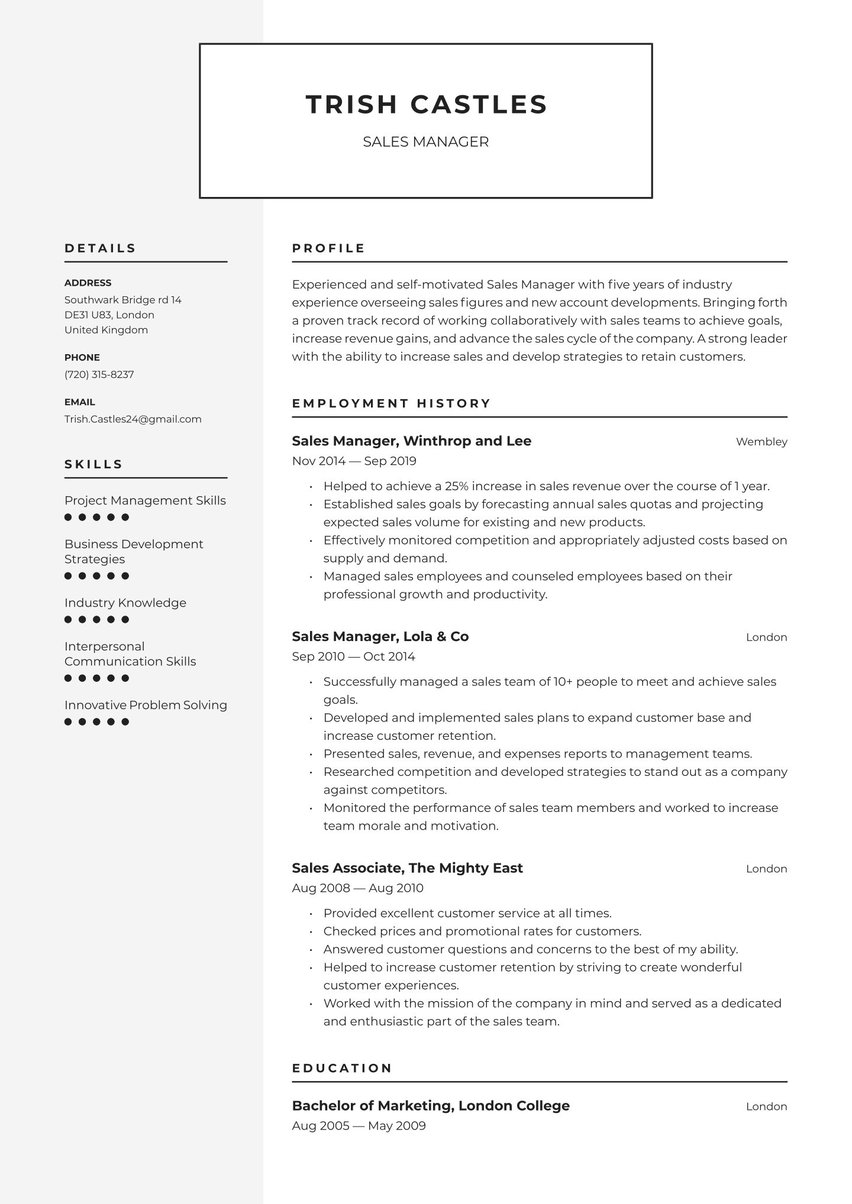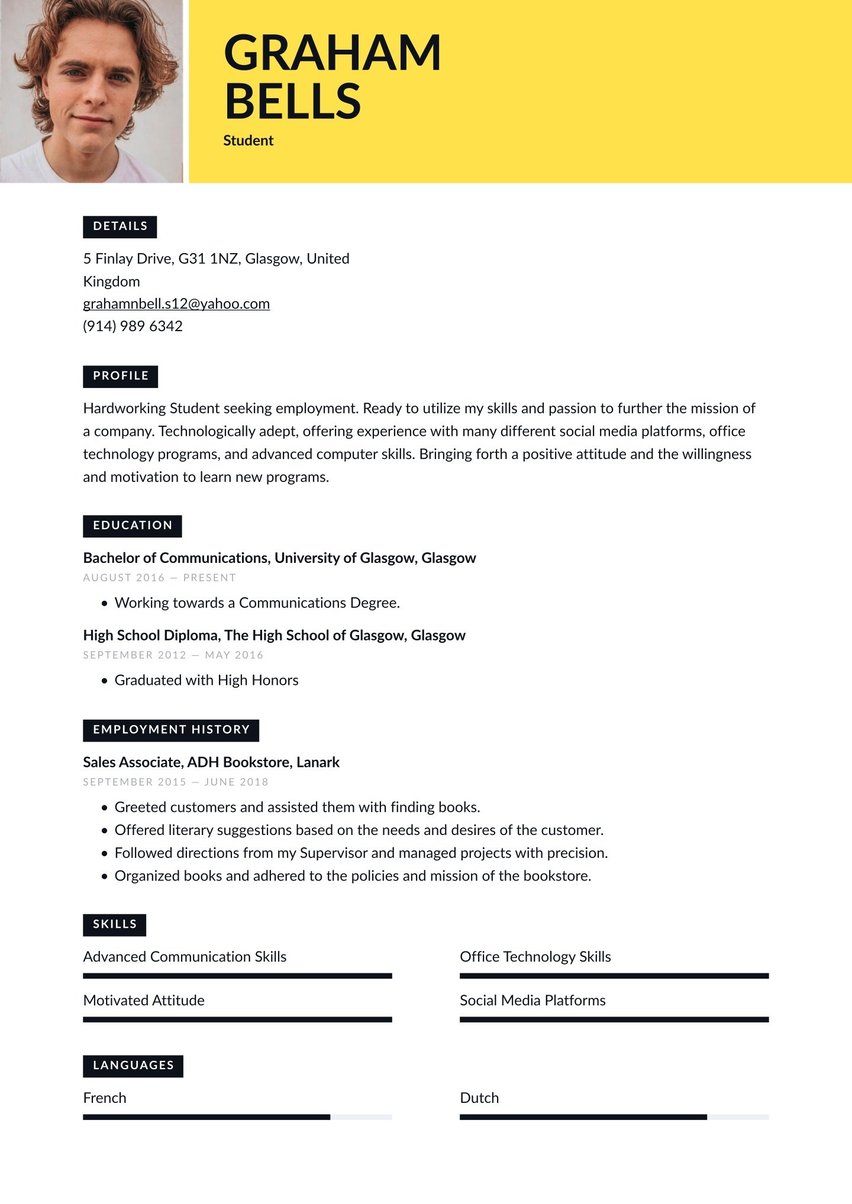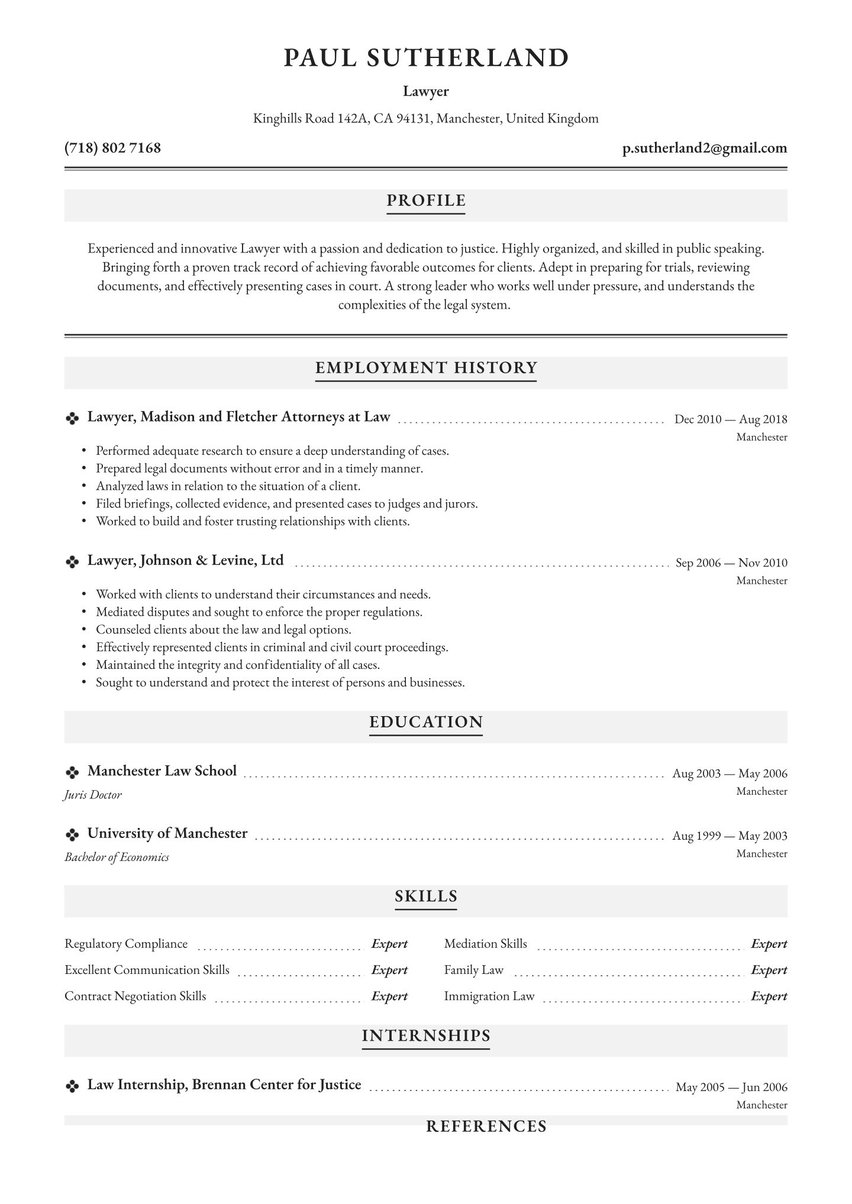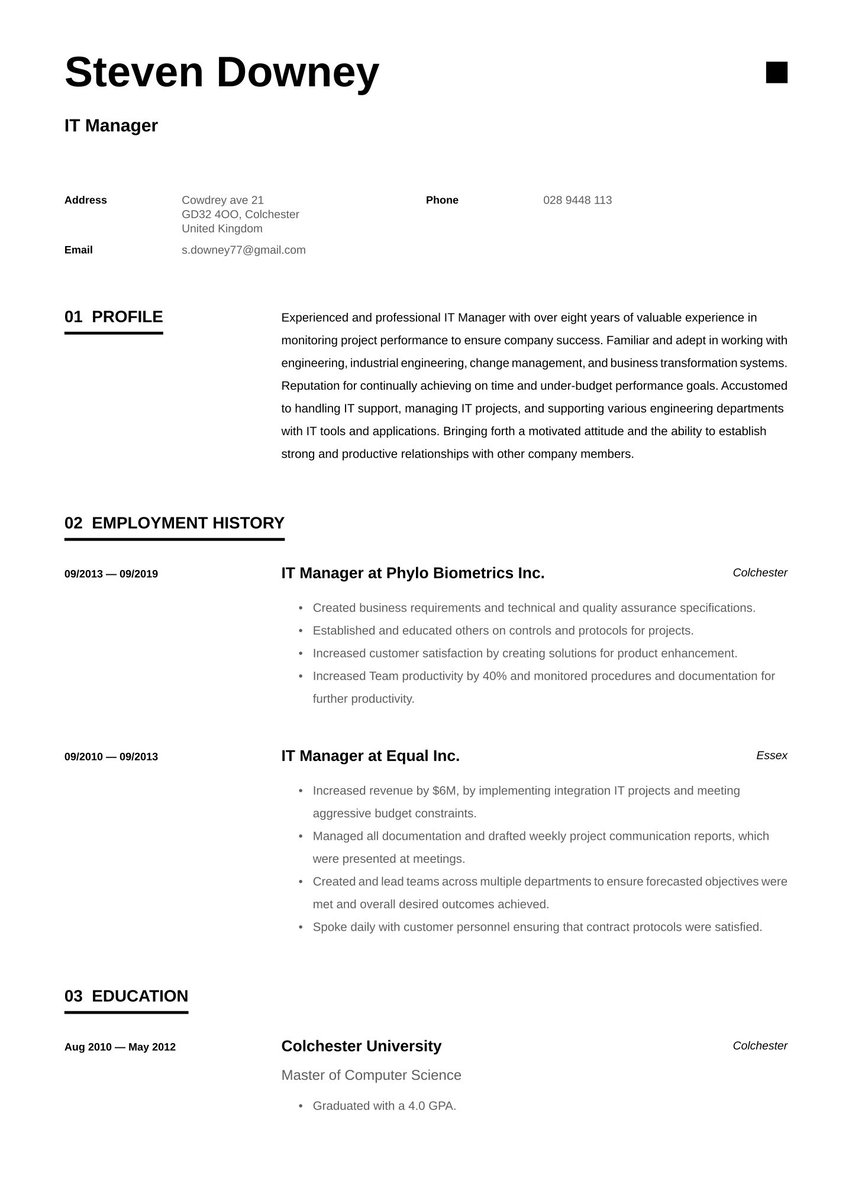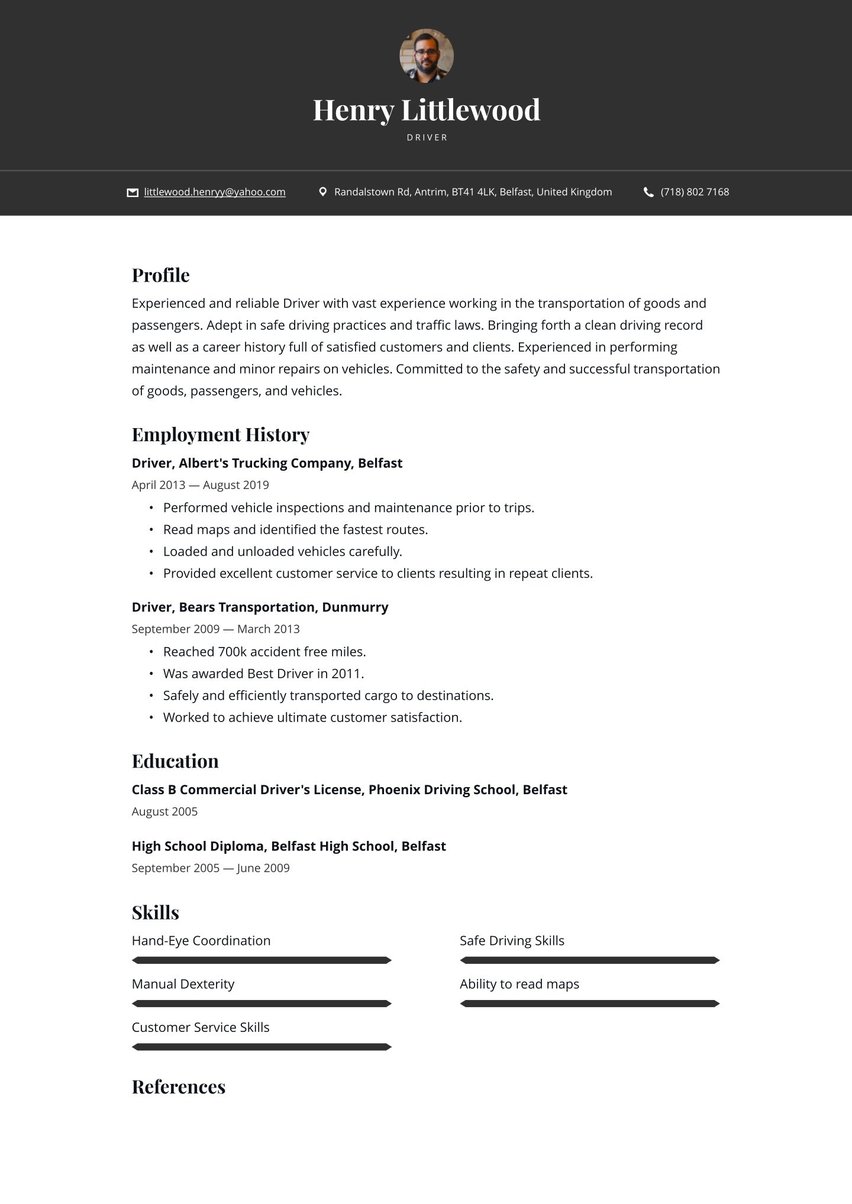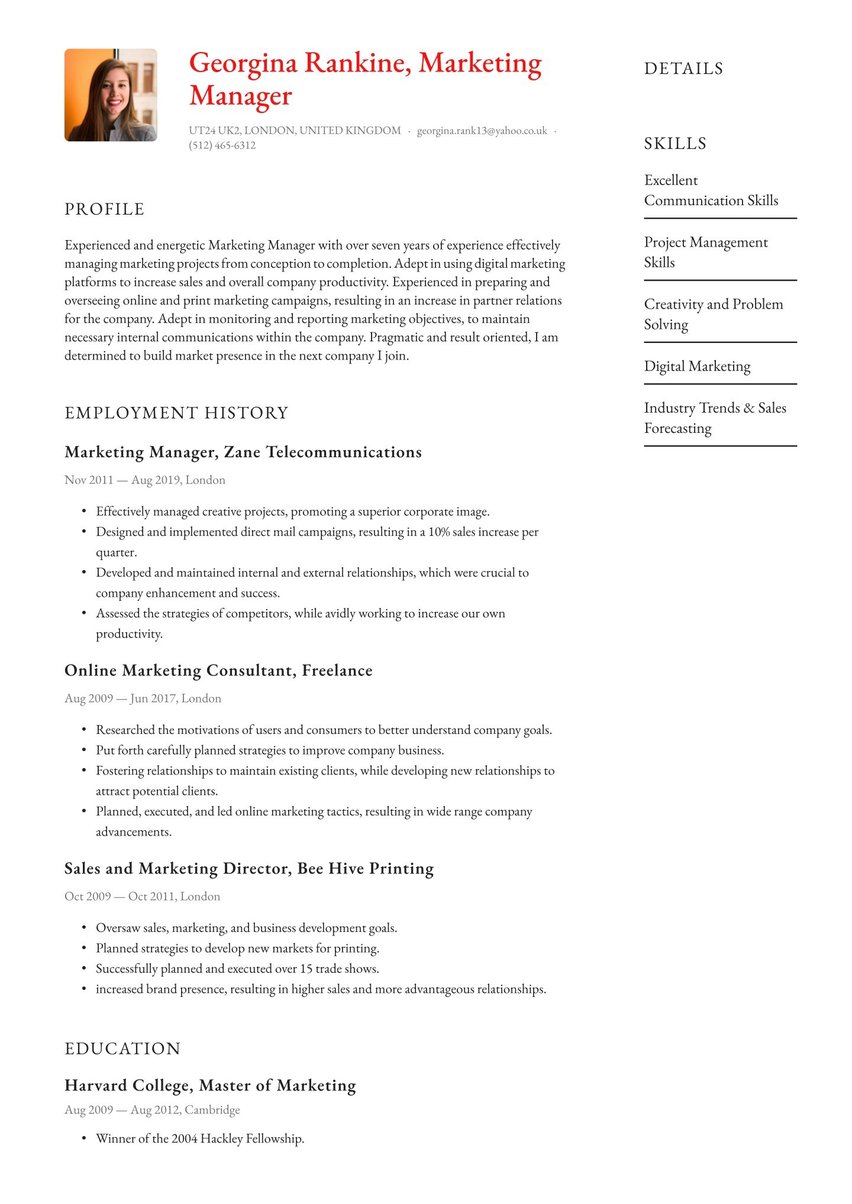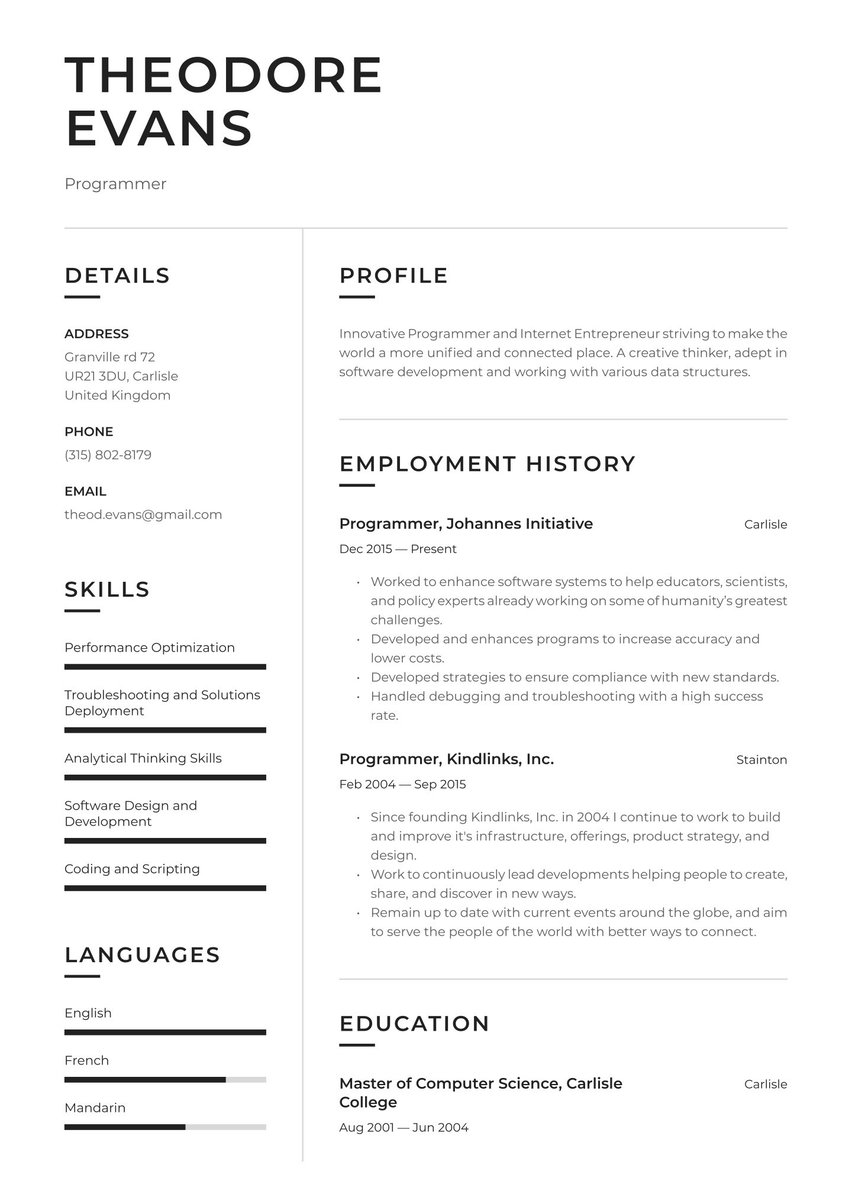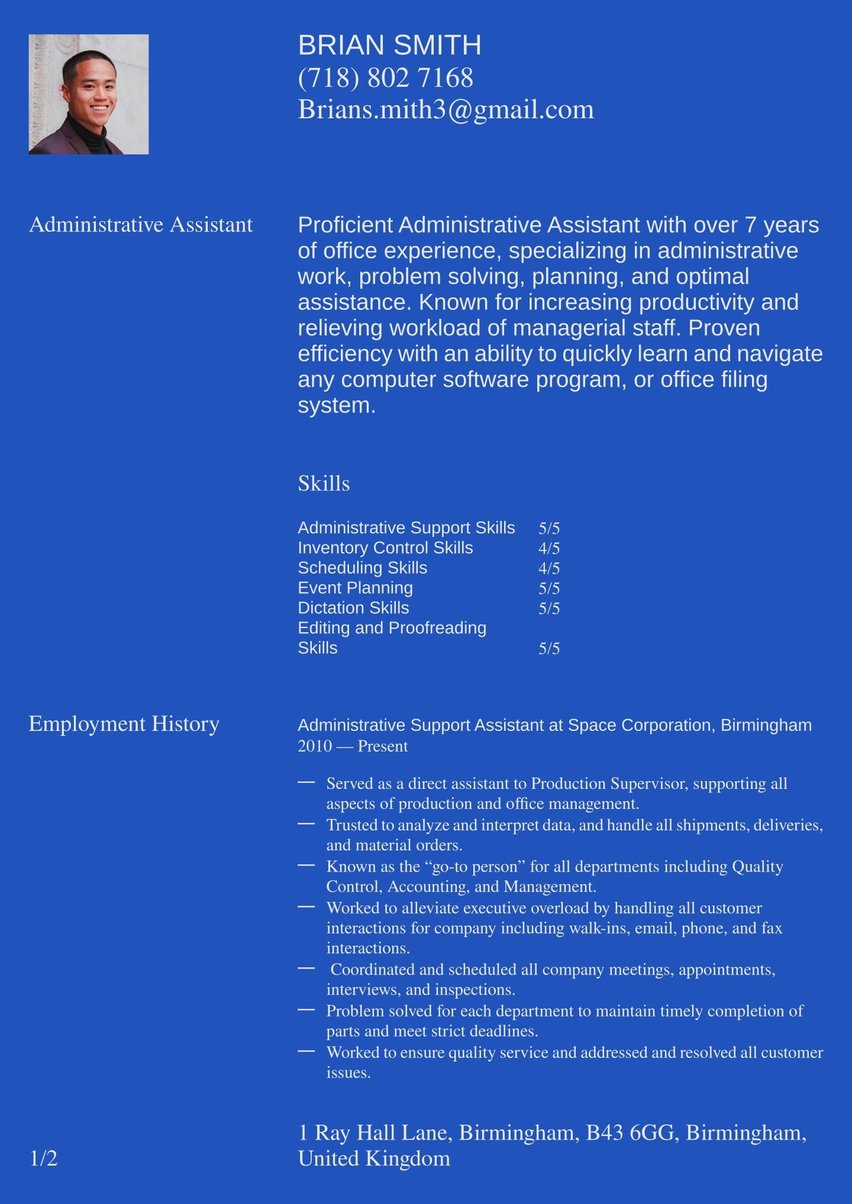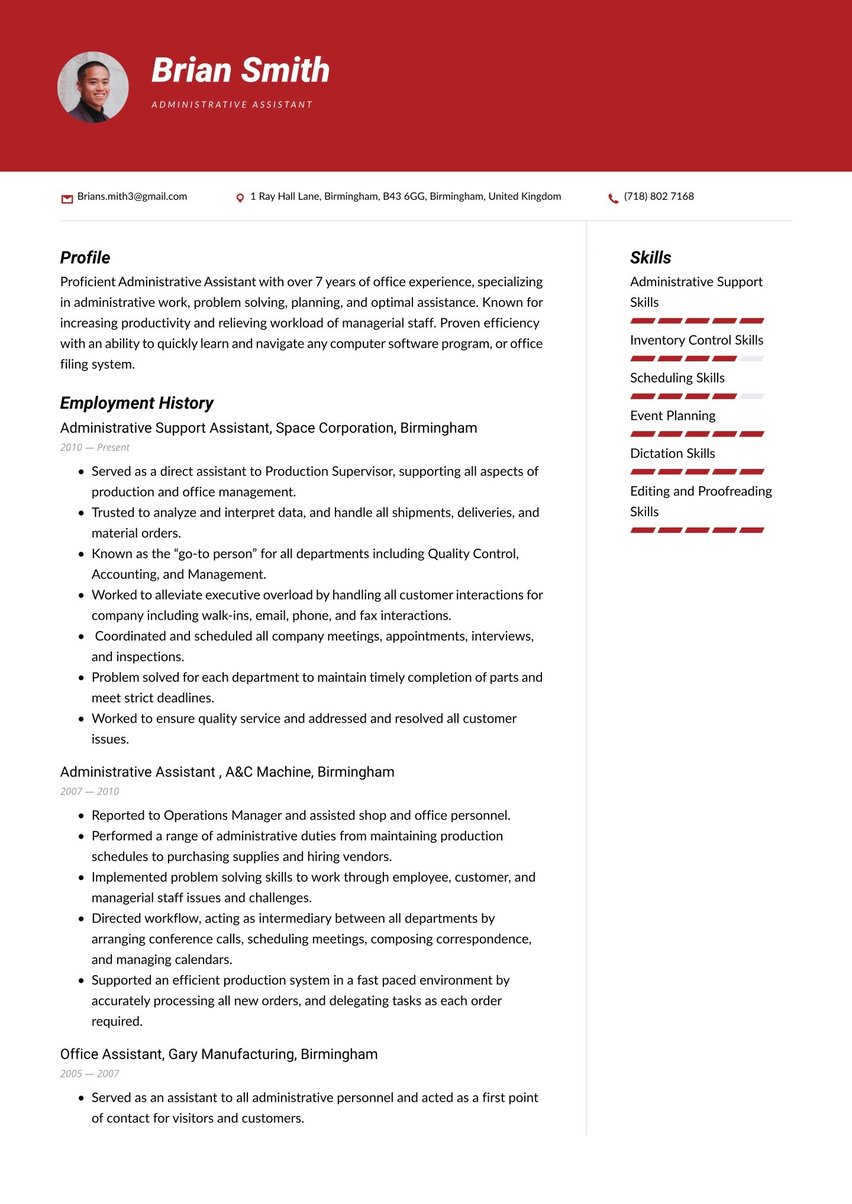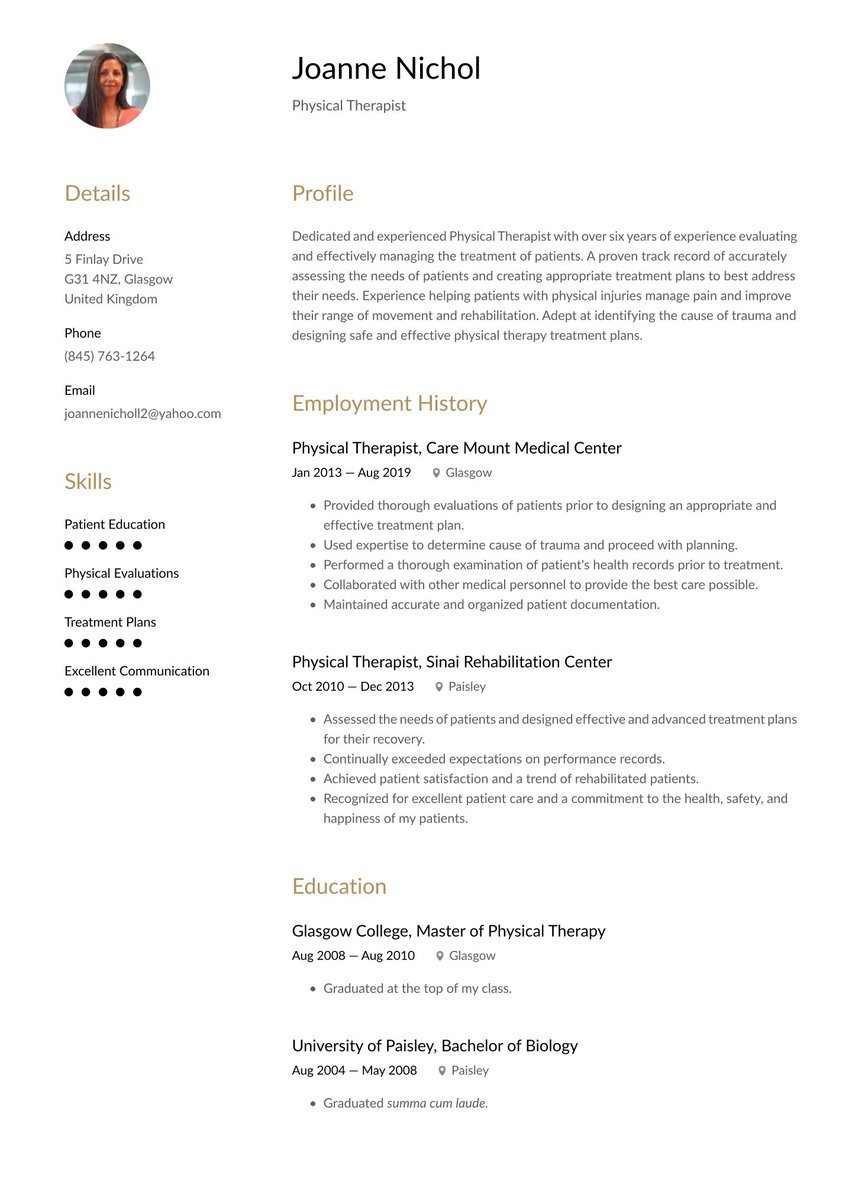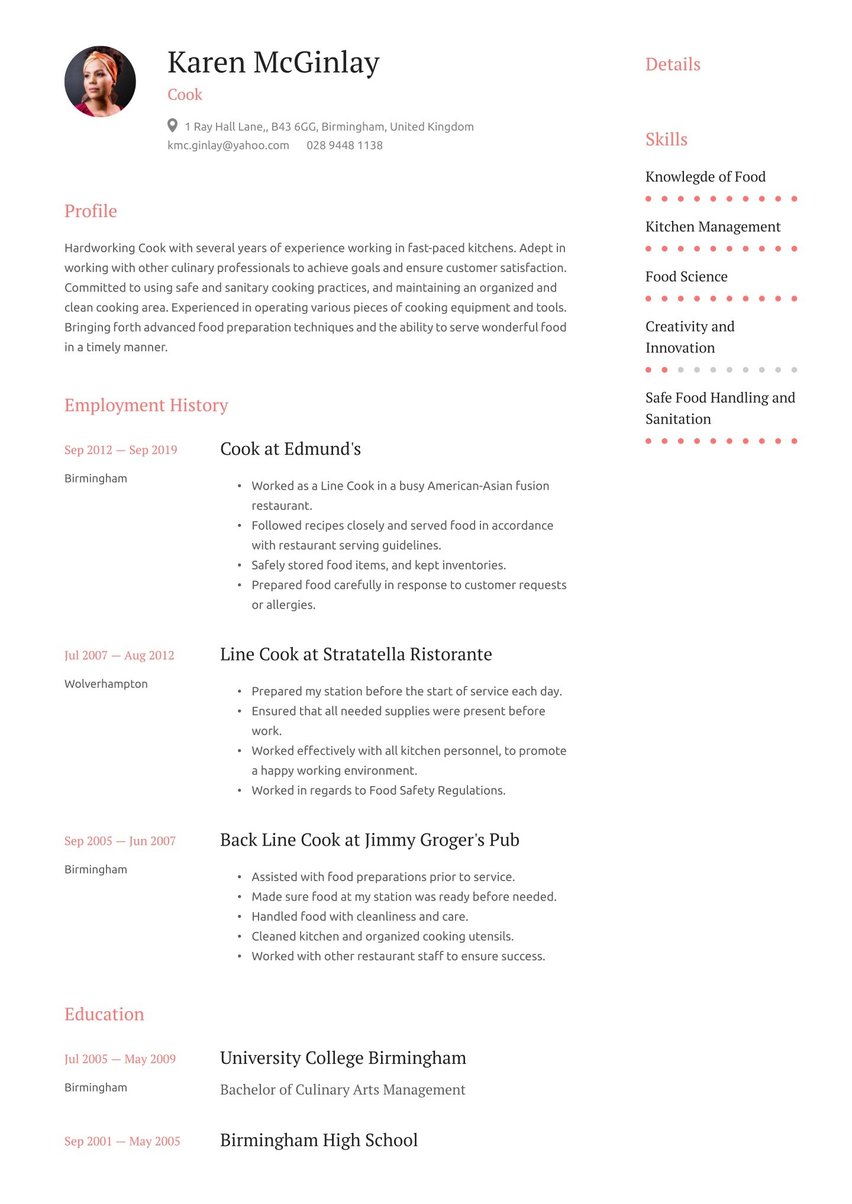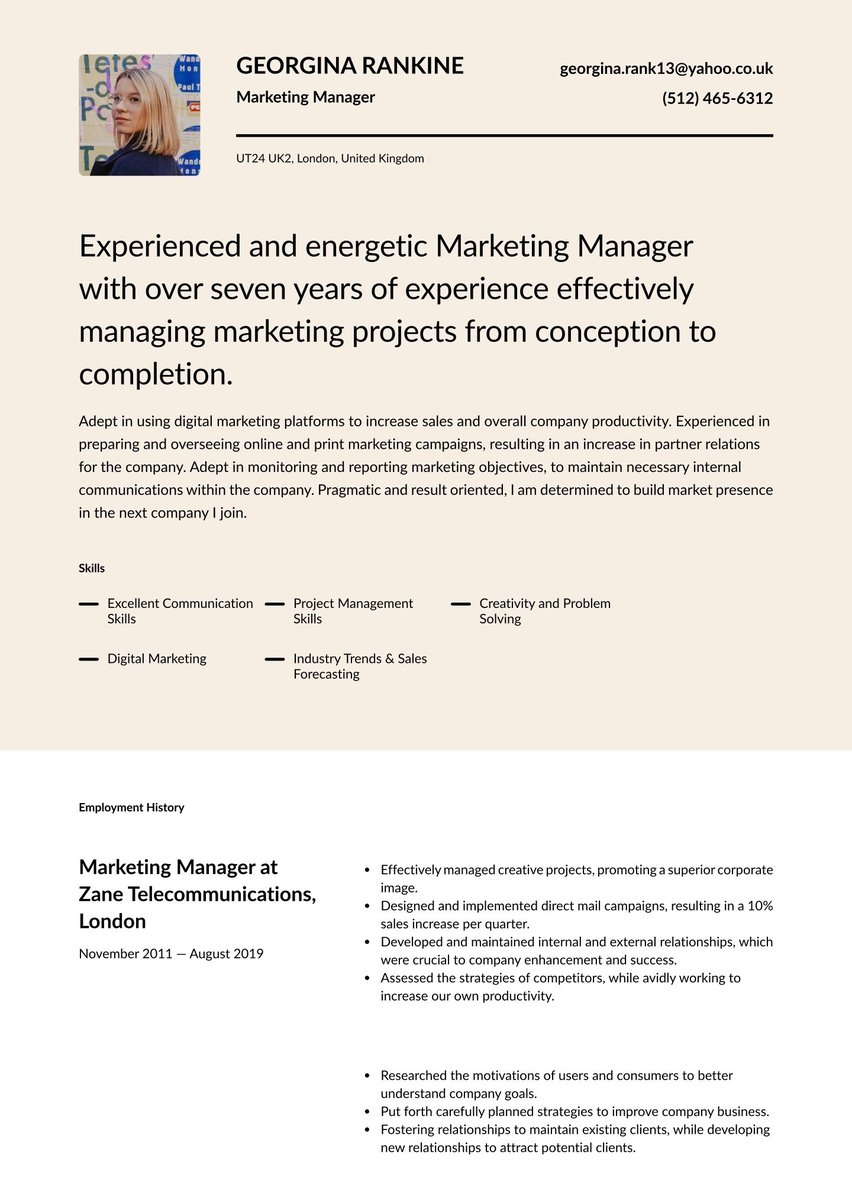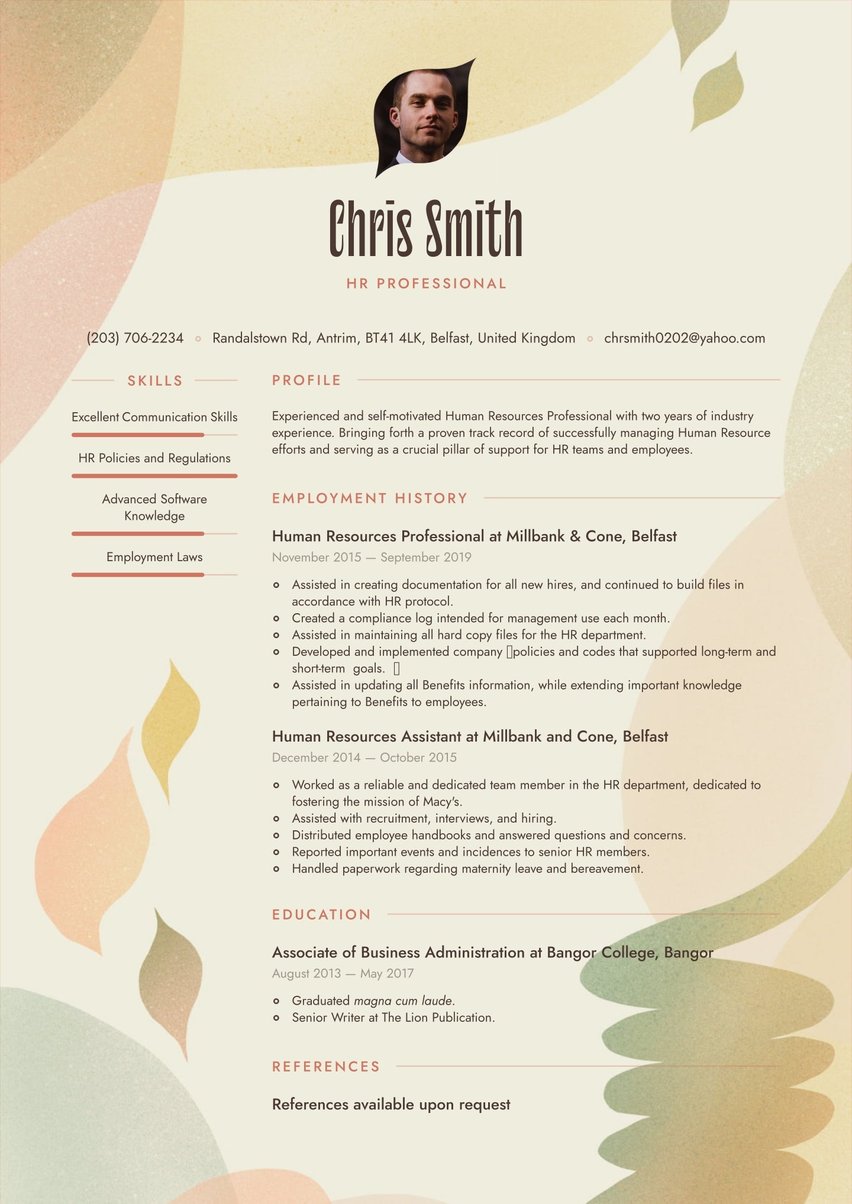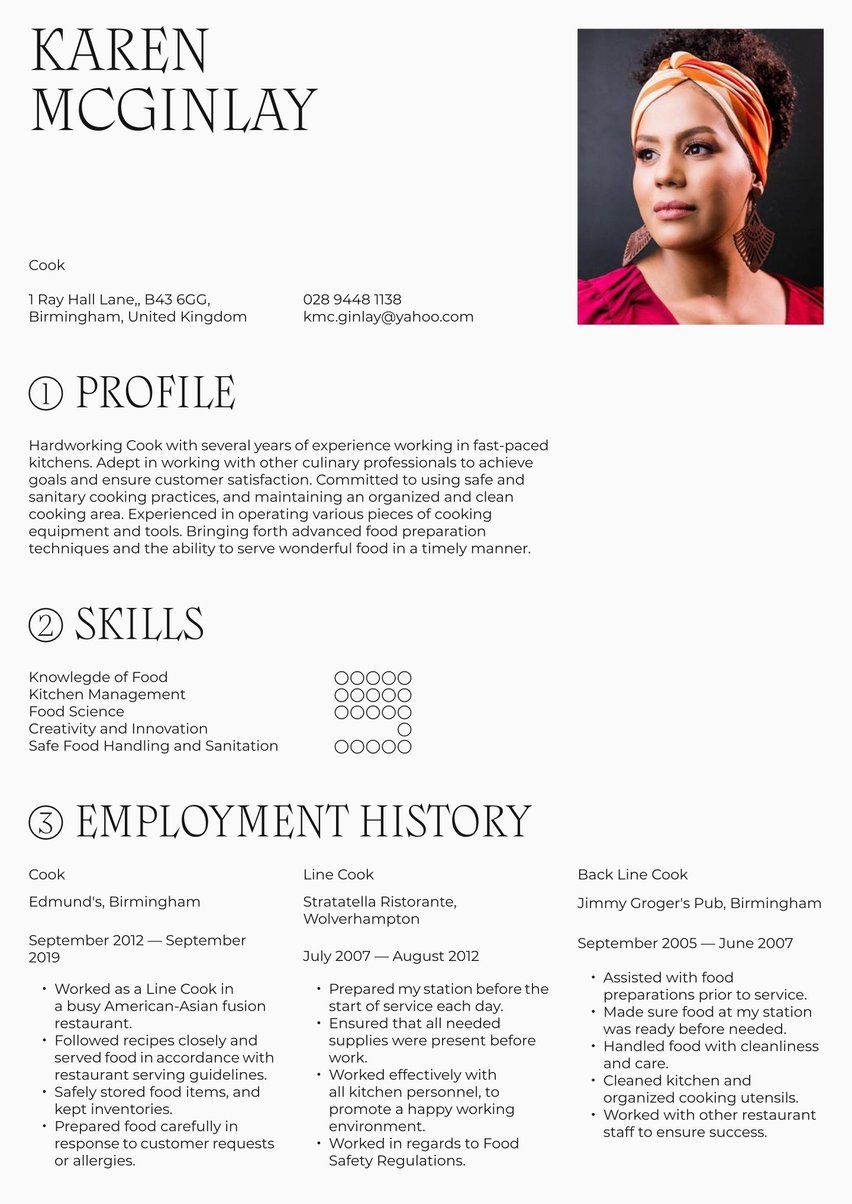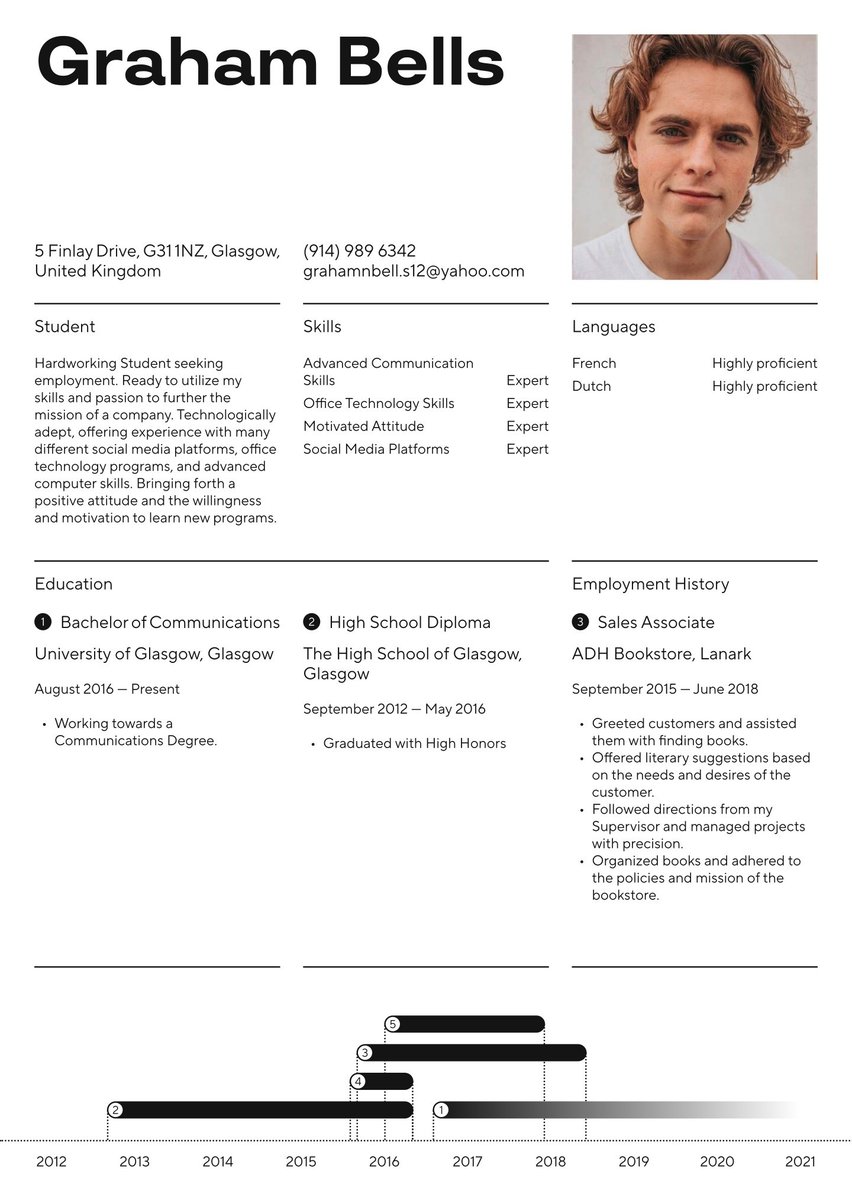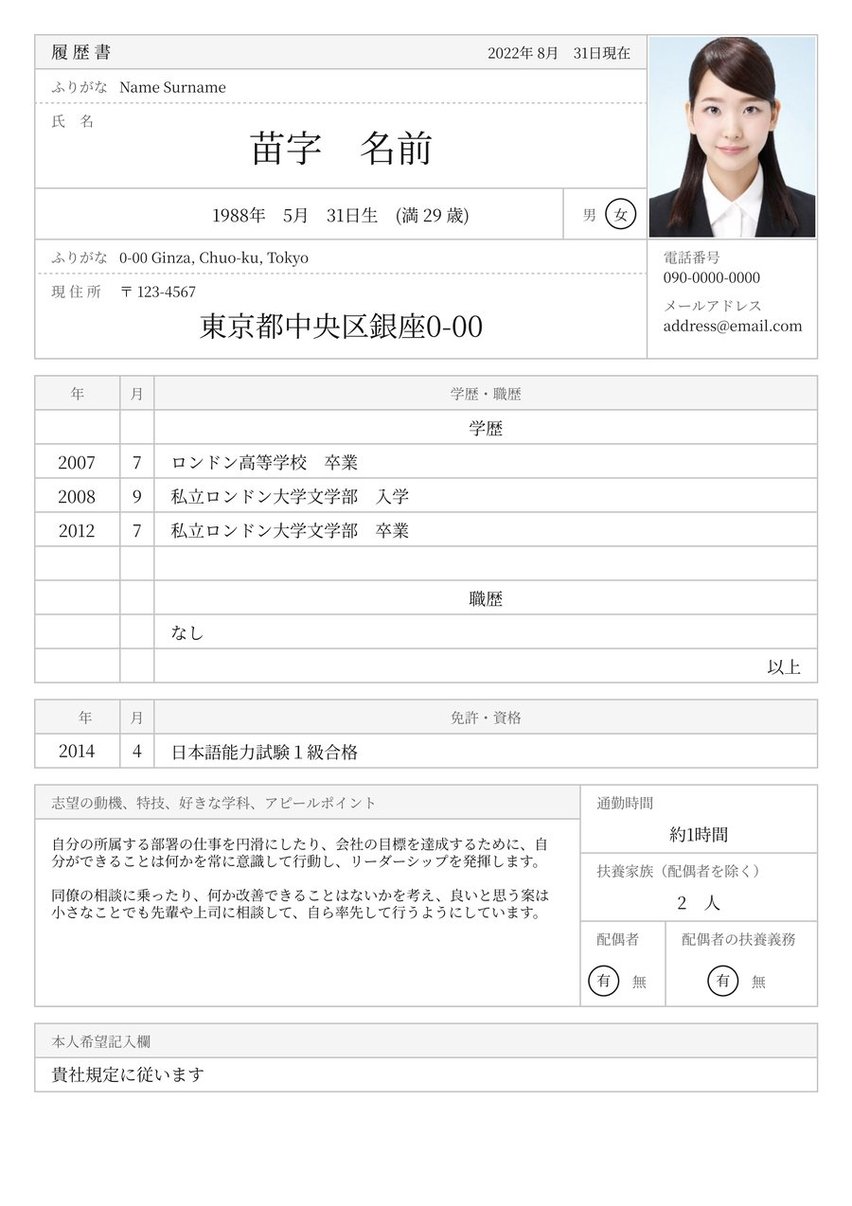Highly analytical and motivated individual with a solid foundation in contract and administrative law. Demonstrated expertise in conducting in-depth legal research, synthesising complex information and drafting a range of legal documents. Strong attention to detail and excellent organisational skills, able to remain on track to meet deadlines in fast-paced environments.
07/2020 - present, Legal Assistant, Linklaters LLP, London
- Supported solicitors in drafting contracts, researching case law and preparing legal documents.
- Organised and indexed case files, ensuring quick and easy accessibility.
- Assisted with internal and external communications, maintaining clear channels between lawyers and clients.
06/2019 - 06/2020, Tutor, Bloomsbury Law Tutors, London
- Provided individualised tutoring to A-level students in Law, Politics and English.
- Developed comprehensive lesson plans and assessment tools aligned with curriculum requirements.
- Ensured students achieved strong understanding of core legal concepts and real-world applications.
01/2017 - 01/2020, BA (Hons) in Jurisprudence, University of Oxford, Oxford
01/2015 - 01/2017, A-Levels: English, Politics, Westminster Sixth Form College, London
- Legal Research Tools and Databases
- Analytical and Critical Thinking
- Written and Verbal Communication
- Attention to Detail
- Deadline Management
- Legal Document Drafting
- Case Law
- Contract Law
- Administrative Law
- Client Relations
- Case File Management
- Team Collaboration
The legal sector is wildly competitive. But, we don’t need to tell you that. As a law student, you will have been listening to the same old story since the first day of classes. If you want to get ahead of the game, it’s smart to start applying for legal roles as soon as possible.
Before you can look for your ideal entry-level job, you need to ensure that you have your law student CV ready. Here at Resume.io, we have just what you need to get started. Our library of CV examples and accompanying writing guides can help you apply for a wide range of roles. In the following law student CV example and writing guide, we will be covering:
- The market outlook for law students here in the UK
- Tips on how to write a law student CV from scratch
- How to choose the best format for your next CV
- What to write in each of the CV sections (plus a CV example)
- Design and layout advice for the finishing touches
What is the outlook for law students?
You’ve (almost) got a law degree under your belt. So, what happens next? With this qualification, the obvious career path is either to become a barrister or a solicitor. However, it doesn’t end there. According to Prospects, alternative job options for law graduates include the following:
- Arbitrator
- Barrister’s clerk
- Chartered legal executive
- Company secretary
- Licenced conveyancer
- Paralegal
- Trade mark attorney
While these positions relate directly to your degree, you may also want to look into roles in which your qualification will be useful. Examples include becoming an advice worker, a tax advisor, or a town planner. Now that you have graduated, take the time to consider what the right path is for you. Figure out what your strengths and passions are, and take it from there.
How many legal professionals are there in the UK?
If you’re looking to get into the legal realm, you’re in good company. According to the latest stats, there were 350,000 legal professionals working in the United Kingdom in the second quarter of 2023. That number was up from 341,600 in the previous quarter.
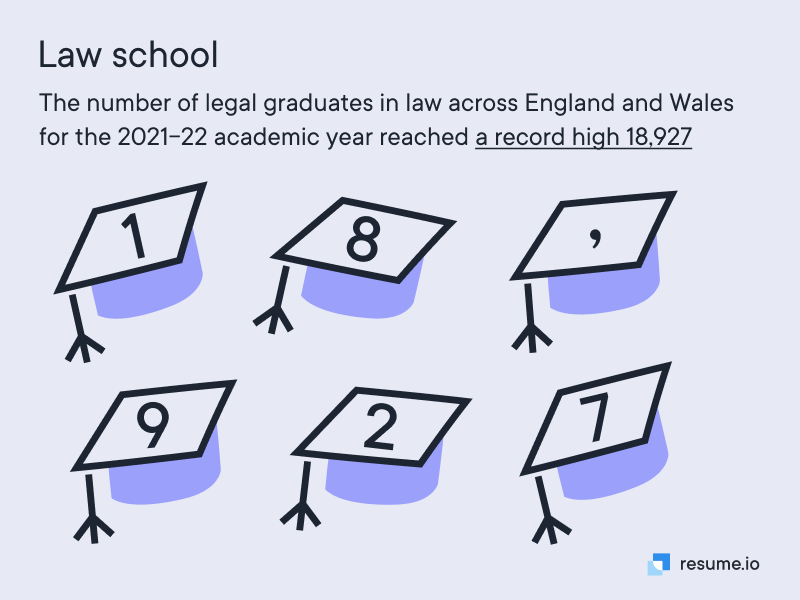
How to write a law student CV
Ready to get started? If you’re eager to apply for legal roles, you need to make sure that your law student CV is up to scratch. The first step in this process is making sure that you are including the right parts. As a rule, your CV should contain the following elements:
- The CV header
- The CV summary (aka profile or personal statement)
- The employment history section
- The CV skills section
- The education section
To ensure that your law student CV is successful, it needs to follow the above outline. Hiring managers expect this structure as it is easy to read and digest quickly. Since each recruiter spends an average of seven seconds reviewing applications, you don’t have time to waste. It’s all about making a big impact as fast as possible. While you may be tempted to do something “creative” or “out of the box,” it’s far smarter to stick to a tried and tested layout.
Before you send your CV to prospective employers, you need to do some groundwork. Tailoring your application to meet the needs of the company (or, indeed, firm) is vital. Start by doing some homework. Look at the company’s website, social presence, and any news surrounding them. By getting to know the employer well, you can adapt your CV to meet their needs. Spend some time editing your application so that it speaks their language.
Legal roles are highly sought after. If you want to make sure that you captivate the hiring manager, the language that you use is important. You should adopt a formal tone while using simplistic terms that anyone can understand. Should you have trouble with this, you can always have a friend or someone you trust read your CV. Ask them whether they understand the main parts of it. If it is too jargon-laden, you might need to change the wording.
Always optimise your application for the ATS!
The moment you hit “send,” you might expect your CV to land in a recruiter’s inbox. However, that is rarely the case. Many companies now use applicant tracking systems (ATS) to filter incoming applications. The software searches for keywords and phrases to see how well your CV fits the criteria of the job. Only the highest-ranking applications will make it past the software and end up being reviewed by the hiring manager.
Want to know how you can beat the bots? While there are many ways in which you can tweak your CV to meet the software’s needs, here’s one tip you can try. Including relevant keywords in your application could be the answer. Look at the original job advert and make a note of any job-specific words that stand out. If these apply to you, sprinkle them throughout your law student CV to boost your chances of landing an interview.
Writing your application from scratch can be a challenge. Perhaps you need some inspiration to help you along the way. Take a look at our law student CV example now:
Choosing the best CV format for a law student
Now that you have an overview of how to write your CV, let’s talk about the format. Generally speaking, you should use a reverse chronological order here. This approach means starting with your most recent experience and qualifications at the top of each section. Work your way back in time as you move down the page. This means that the reader can quickly see what your latest accomplishments are. After all, that’s what matters the most to them!
Every rule has an exception. In some cases, it may be better to use either a functional or hybrid CV format here. For more information on the best CV formats, read our guide now.
Applying for multiple roles? If you want to have your fingers in many pots, we’ve got you covered. Take a look at the following CV samples and writing guides:
CV summary example
Standing out in a sea of other qualified candidates is rarely easy. One way that you can make your mark on the hiring manager is to write an engaging CV summary. This is the short paragraph that typically sits at the top of the page. It consists of 3-4 lines detailing your greatest accomplishments and what you bring to the table. Make sure that this part of your application packs a real punch. You need to show off what it is that makes you unique.
Highly analytical and motivated individual with a solid foundation in contract and administrative law. Demonstrated expertise in conducting in-depth legal research, synthesising complex information and drafting a range of legal documents. Strong attention to detail and excellent organisational skills, able to remain on track to meet deadlines in fast-paced environments.
Employment history sample
If you’re a law student, you might not have a whole load of experience yet. That is perfectly understandable. Use this section to write about any voluntary positions or part-time jobs you have held over the years. Once again, you need to use the reverse chronological format when listing the roles that you have had in the past. Include between two and three jobs.
Legal Assistant at Linklaters LLP, London
July 2020 - Present
- Supported solicitors in drafting contracts, researching case law and preparing legal documents.
- Organised and indexed case files, ensuring quick and easy accessibility.
- Assisted with internal and external communications, maintaining clear channels between lawyers and clients.
Tutor at Bloomsbury Law Tutors, London
June 2019 - June 2020
- Provided individualised tutoring to A-level students in Law, Politics and English.
- Developed comprehensive lesson plans and assessment tools aligned with curriculum requirements.
- Ensured students achieved strong understanding of core legal concepts and real-world applications.
CV skills example
Chances are, you have learned a selection of applicable skills at university. Now is the time to shout about them. Don’t be shy when it comes to listing your talents. The aim of the game is to set yourself apart from the crowd. Make sure that you include both hard and soft skills. The hiring manager will be looking for well-rounded candidates that have more than just a legal mind. If you can show that you have it all, you will be a shoe in the door.
- Legal Research Tools and Databases
- Analytical and Critical Thinking
- Written and Verbal Communication
- Attention to Detail
- Deadline Management
- Legal Document Drafting
- Case Law
- Contract Law
- Administrative Law
- Client Relations
- Case File Management
- Team Collaboration
Law student CV education example
Your education is the centrepiece of your application. If you have not yet graduated from your law degree, you can still list it on your CV. Simply ensure that you make it clear that this is an ongoing qualification. You can also include your secondary school and sixth form (or college) education on your application. However, you don’t need to go into much detail.
BA (Hons) in Jurisprudence, University of Oxford, Oxford
2017 - 2020
A-Levels: English, Politics, Westminster Sixth Form College, London
2015 - 2017
CV layout and design
By this point, you already know how to write your law student CV. So, let’s talk about the design. Your application needs to be clean and straightforward. The roles for which you are applying will be highly formal. You need to make sure that your application matches that.
Wherever possible, make use of white space. That means not cramming your CV with too much information. Leave appropriate gaps around the sections and edges of the document. If you want some help along the way, check out one of our field-tested CV templates now.
Key takeaways for a law student CV
- Breaking into the legal field can be tough. Before you get started, you need to decide which pathway is right for you and your future.
- Writing a law student CV doesn’t have to be hard. Simply make sure that you tailor your application to meet the needs of the employer.
- Always optimise your application for the ATS software. This small hack could make the world of difference when you’re applying for jobs.
- Keep the design plain and minimal. A classic look is a surefire way to get ahead!

